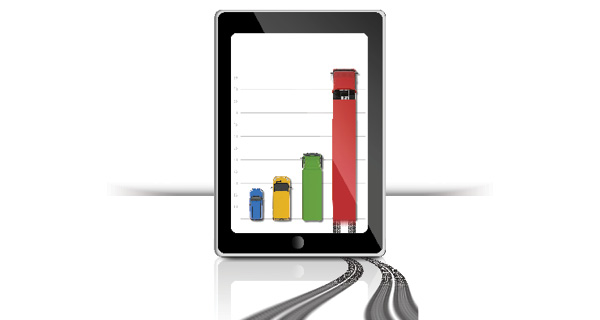Articles
Logistics I.T.

Regulation as an Opportunity
Manufacturers are facing an increasing number of regulations in a variety of areas from increasing food safety to meeting specific ground-level ozone policies. The FDA Food Safety Modernization Act of 2010, signed into law in 2011, is just one example of recent legislation. Resulting from widespread cases of tainted eggs and peanut butter, the sweeping […]
Read More
Trends—September 2014
HCS Updates: Asked and Answered The Occupational Safety and Health Administration‘s (OSHA) 2012 Hazard Communication Standard (HCS) is sure to elicit a supply chain reaction from chemical manufacturers, distributors, and end users. The updates to HCS 1994, OSHA’s previous convention, feature some cosmetic changes—"material safety data sheets" are now referred to as "safety data sheets"— […]
Read More
A Mobile Cure for the Warehouse Blues
Companies are under constant pressure to improve warehouse efficiency and reduce errors. Mobile communications technologies help them rise to the challenge.
Read More
Freight Audit and Payment Services: Stacking Up Savings
Analyzing shipment data can reveal trouble spots and identify opportunities to cut costs. Freight audit and payment services provide the supply chain analytics and expertise to give shippers an edge.
Read More
Choosing Enterprise vs. Software-as-a-Service TMS
Q: What platform options are available to companies investing in transportation management systems? A: Transportation management systems (TMS) come in two essential forms. The traditional form is enterprise software—applications installed on servers that you buy and maintain. The more recent—though hardly new—form is Software-as-a-Service (SaaS), which is provided and maintained by a vendor on the […]
Read More
Electronic On-board Recorders: The Gateway to Intelligent Fleet Management
As the transportation industry continues to evolve, more fleets are reverting from commercial on-board computers back to running fleet management software on drivers’ personal devices. The main reason for this is cost, as companies generally view the hardware as free. Personal devices frequently break and need replacement, however, because they aren’t designed for the rugged […]
Read More
The New Retail: Three Legs to Stand On
Did you ever read a magazine or newspaper article and get the feeling that something was missing? It happened to me when I read several business press articles touting e-commerce as the savior of retailers. That "something’s missing" feeling bothered me as I read various vague descriptions of how e-commerce is the driving force behind […]
Read More
Selecting the Right Technology to Support Your Lean Operations
Technology plays a key role in enabling Lean supply chain operations. For example, connecting to suppliers in real time facilitates re-supplying parts and materials for a just-in-time production environment. But choosing the wrong software can create waste in terms of the time, effort, and money spent evaluating, selecting, implementing, and using the system. Surveys commonly […]
Read MoreDiving Into Multi-Channel Fulfillment
KaiKini Bikinis’ integrated inventory control and shipping operations solution brings savings that are anything but itsy bitsy teeny weeny.
Read More
How the Internet of Things Impacts Supply Chains
When someone mentions the Internet of Things (IoT), most people think of electronics or wearables – the types of technologies that are driving adoption of a highly personalized “smart” consumer lifestyle. But there’s much more to the IoT story, and more specifically, its impact on the supply chain. Research firm Gartner recently released a write-up […]
Read More
Forecasting Seasonal Surges Keeps Products on the Shelf
During busy retail periods, news of retail imports and spot transportation rates tends to grab all the attention. Less prominent, but more interesting, is the constant seasonal and promotional flux in domestic consumer packaged goods (CPG), and how manufacturers manage the resulting transportation surge. For CPG companies, seasonal volume typically represents one-third of annual shipments, […]
Read More
LTL Leaders Make Tracks for the Web
Less-than-truckload (LTL) carriers are parking on freight portals to offer extra capacity to small shippers surfing for low-cost transportation.
Read More
SaaS TMS Facilitates Carrier Management
Q: How can shippers navigate today’s tight capacity market? A: For companies to have the assurance of consistent, competitively priced, service-oriented capacity through the ups and downs of the transportation marketplace, being a shipper of choice is imperative. Here are a few tips to get started: Go beyond rates. Best practice suggests taking a multi-tiered […]
Read More
Empowering Companies Through Integrated Data Flows
Q: What are some key data management challenges in logistics today? A: One key challenge is the different types of information flows. For example, some companies use electronic data interchange; others prefer XML or flat file. The choice often depends on the industry vertical, the company’s capabilities, and how their suppliers operate. For example, in […]
Read More
Partners and Process Management: Freight Business From the Inside Out
Q: What is the key to managing freight spend in today’s supply chain? A: Efficiency at every level of the supply chain is of the utmost importance in controlling costs. Carriers and shippers alike need to formulate their strategies based on key performance indicators (KPIs). Making routine a simple action such as generating useful reports […]
Read MoreWheel Genius: Racing to Improve Data Collection
Thanks to a new image-based scanner, bar-code reader errors no longer tread on Champion Tire and Wheel’s productivity.
Read More
Taking a Smarter Approach to WMS RFPs
To understand where request for proposals (RFPs) for warehouse management systems (WMS) often go wrong, imagine for a moment you are being interviewed for admission to your dream college. You try to demonstrate the specific reasons why you would be a great addition to that school. But instead of engaging in a friendly dialog, the […]
Read More
Measuring the Value of Warehouse Data
In today’s highly global manufacturing and supply chain economy, it’s no surprise that manufacturers need to embrace better communication to manage cultural, geographic, and language differences so as to operate effectively. In the end, better communication means better efficiency, less waste, and higher customer satisfaction. Complex, global economic issues have only increased the difficulty in […]
Read MoreImplementing an ERP System
Using an enterprise resource planning (ERP) system can significantly enhance supply chain management performance by improving purchasing, inventory control, and information exchange between internal departments, as well as external partners. Mark Butler, manager of professional services at software solutions provider Cincom Systems, offers these insights on implementing an ERP system. 1. Understand your current system’s […]
Read More
Freight Bill Payment: Meeting the Pepsi Challenge
When Pepsi Logistics Company Inc. (PLCI) was thirsty for an automated system for billing customers, and processing and paying carrier freight bills, it whet its whistle with Epay Manager from Level One Technologies. To understand Plano, Texas-based PLCI’s thirst for automation, consider its size and scope. PLCI manages parent company PepsiCo’s private fleet, one of […]
Read More